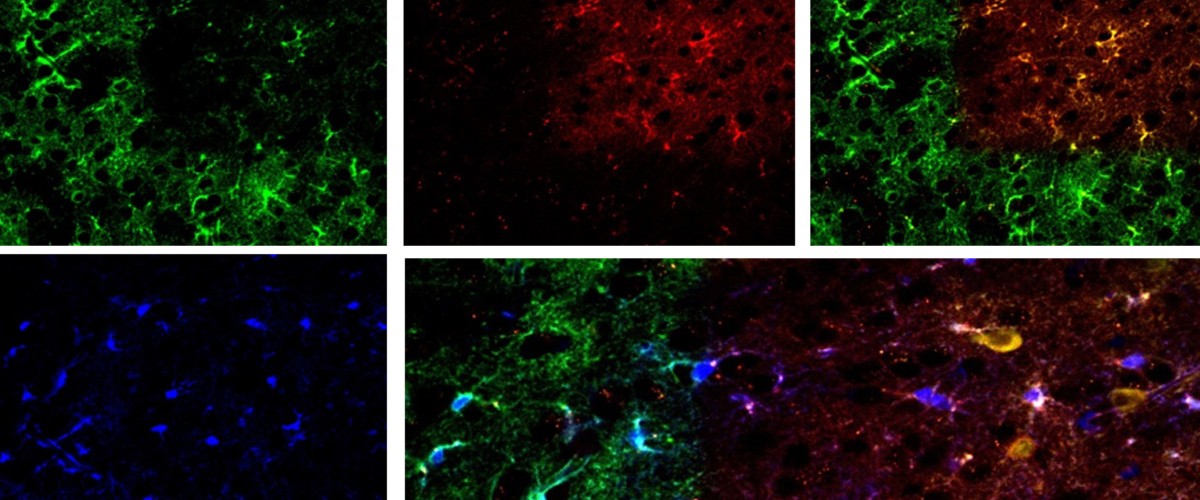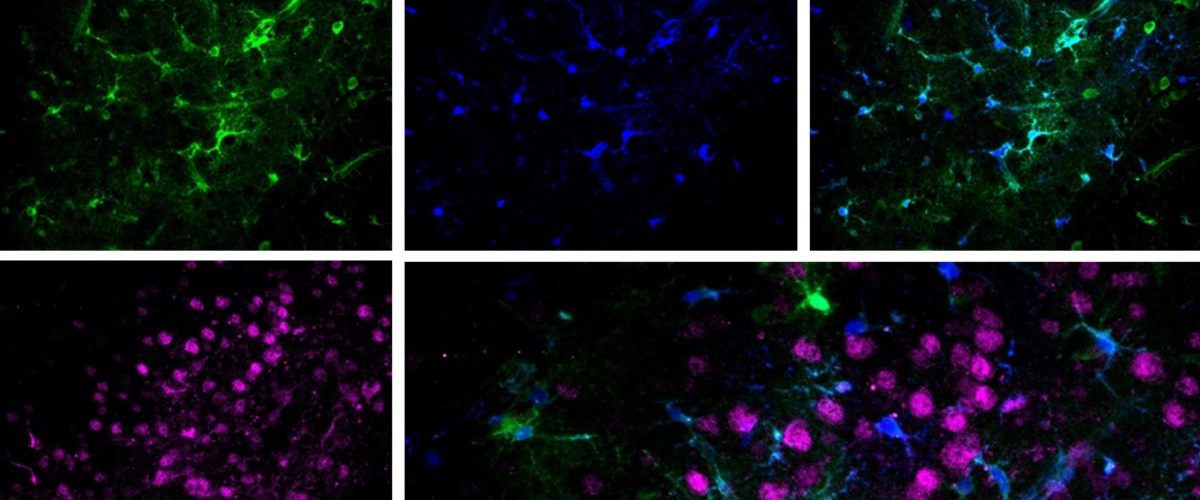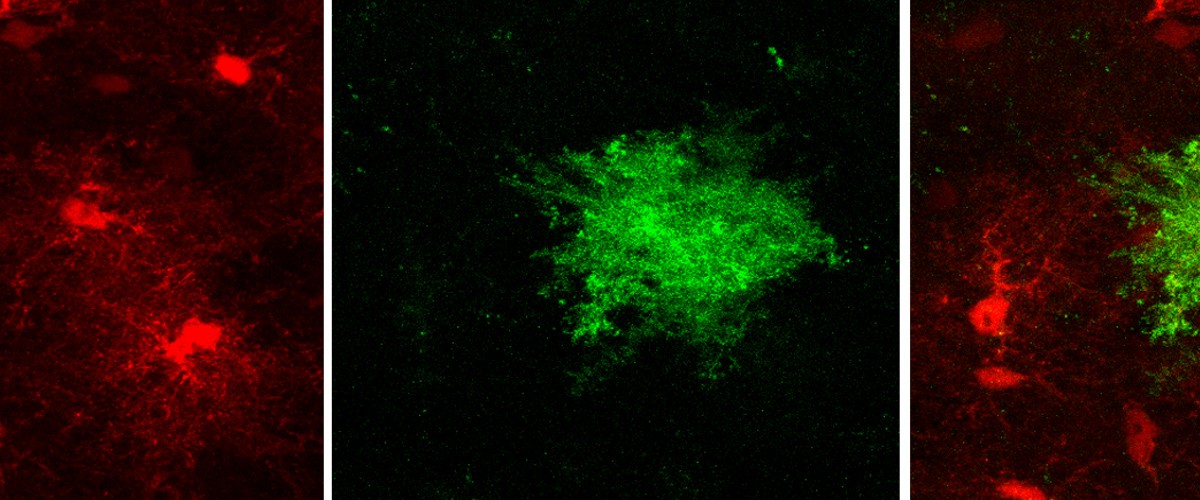LABORATORIOS
Plasticidad sináptica e interacciones astrocito-neurona
Plasticidad sináptica e interacciones astrocito-neurona
Investigación
Personal
Publicaciones
Contacto
Otros
Investigación
Los cerebros de los mamíferos evolutivamente superiores están dotados de capacidades de procesamiento de la información que les permiten realizar tareas de planificación, toma de decisiones, aprendizaje y memoria. Aunque estas funciones cerebrales tan desarrolladas se suelen adjudicar exclusivamente a la función neuronal, recientes estudios apuntan a un importante papel de la glía, especialmente a los astrocitos, en el comportamiento, funciones cognitivas y patologías cerebrales. Cómo ejercen ese control los astrocitos es la cuestión principal en la que se centra el Laboratorio de Plasticidad Sináptica e Interacciones Astrocitarias-Neuronales.

Nuestra investigación actual se centra en el estudio del papel de los astrocitos en la modulación de la función sináptica y de la red neuronal, con el objetivo de comprender su papel en los aspectos fisiológicos y patológicos de la función cerebral. Más concretamente,
- Desarrollamos herramientas que permitan manipular la diversidad de astrocitos. Las redes neurona-astrocito muestran un sorprendente grado de complejidad y se requieren herramientas complementarias de última generación para comprender la participación de los astrocitos en la modulación de los circuitos y el comportamiento. Aunque la evolución de las herramientas genéticas para estudiar y controlar estos circuitos se ha centrado principalmente en la actividad neuronal, el Laboratorio de Plasticidad Sináptica e Interacciones Astrocíticas-Neuronales se ha centrado en el desarrollo de técnicas para diseccionar específicamente los circuitos astrocitarios activos con precisión espacio-temporal.
- Determinar el papel de las redes astrogliales en el control de la actividad de la red y las funciones ejecutivas relacionadas en el Núcleo Accumbens. Debido a la dificultad de inducir la manipulación in vivo de astrocitos específicos, sólo un puñado de estudios han investigado directamente la participación de determinados conjuntos de astrocitos en un comportamiento específico.
- Mientras que los mecanismos neuronales que subyacen a la plasticidad sináptica han sido ampliamente identificados, la participación de los astrocitos en estos procesos ha sido menos reconocida. Estamos abordando la participación de los astrocitos en el aprendizaje y la memoria desde diferentes aspectos, estudiando 1.- si los astrocitos son capaces de codificar de forma independiente algunas características de la memoria y 2.- si la gliotransmisión afecta a la fuerza de la conectividad entre regiones cerebrales.
Desentrañar cómo los astrocitos controlan la actividad de los circuitos neuronales es indispensable, no sólo para lograr una disección exhaustiva del procesamiento de la información cerebral, sino también para proporcionar un marco novedoso que permita identificar objetivos terapéuticos alternativos.
Equipo
Electrofisiología in vitro.
Electrofisiología in vivo.
Imagen por fibra óptica.
Imágen dinámica de calcio
Optogenética.
Quimogenética.
Histología.
Ratones transgénicos.






Personal

Marta Navarrete
Investigadora principal

Cristina Martín
Investigadora predoctoral

Javier Sánchez
Investigador predoctoral
Javier Sáchez-Romero (Estudiante predoctoral): Fundación Tatiana fellowship- “Decodificación del diálogo Astrocito-Neurona en el Núcleo Accumbens” Defense expected, 2026.
Cristina Martín-Monteagudo (Estudiante predoctoral): FPU fellowship -FPU19/001667- “Astrocytes control the cognitive impairment derived from chronic exposure to THC” Defense expected, 2025.
Antiguos miembros del laboratorio:
Irene Serra Hueto (Estudiante predoctoral): “Astrocyte heterogeneity in the Nucleus Accumbens” Defensa de tesis doctoral, 31 de Enero 2025. This project studies the functional heterogeneity of Nucleus Accumbens astrocytes by a multidisciplinary approach based on implementing new molecular tools for astrocytes which allow the characterization and modulation of specific neuron-astrocytes circuits within the nucleus.
Laura Delgado (Estudiante predoctoral): CAM fellowship -PEJ-2020-AI/BMD-18245- “Probing Astrocytic Integration in the Accumbens-Pallidal circuits that supports cognitive processing”. Defense expected 2024. This project will allow the laboratory to get immersed in areas of knowledge so far unexplored, such as the analysis of signals, and the set-up and fine-tuning of newly purchased equipment involved in in-vivo signals acquisition.
Publicaciones
Publicaciones destacadas
- Serra I, Martín-Monteagudo C*, Sánchez Romero J*, Quintanilla J.P, Ganchala D, Arevalo M.A, García Marqués J, Navarrete M. (2025) Astrocyte ensembles manipulated with AstroLight tune cue-motivated behavior. Nature Neuroscience. doi: 10.1038/s41593-025-01870-0
- Serra I & Navarrete M. (2024) Mapping Neuron–Astrocyte Circuits with CaMPARIGFAP. In: Rusakov, D. (eds) Fluorescence Imaging of the Brain. Neuromethods, vol 209. Humana, New York, NY. doi: 10.1007/978-1-0716-4011-1_8
- Justin L, Baraibar A, Nanclares C, Martín ED, Aguilar J, Kofuji P, Navarrete M&´, Araque A&´. (2023) A spatial threshold for astrocyte calcium surge. eLife doi:10.7554/eLife.90046 (&´ Senior authors)
- Gonçalves-Ribeiro J, Savchak O, Costa-Pinto S, et al., (2024) Adenosine receptors are the on-and-off switch of astrocytic CB1 receptor effect upon synaptic plasticity in the medial prefrontal cortex. Glia doi: 10.1002/glia.24518
- Delgado L & Navarrete M. (2022) Shining the Light on Astrocytic Ensembles. Cells doi: 10.3390/cells12091253
- Serra I, Esparza J, Delgado L, Martin-Monteagudo C, Puigròs M, Podlesniy P, Trullas R, Navarrete M. (2022) Ca2+-modulated Photoactivatable Imaging Reveals Neuron-Astrocyte Glutamatergic Circuitries within the Nucleus Accumbens. Nature Communications doi: 10.1038/s41467-022-33020-6
- Fernandez JM, Martinez-Rachadell L, Navarrete M, Palenzuela R, Ruiz de Martin Esteban S, Mostany R, Davila JC, Garcia-Caceres C, Tschöp M, Gutierrez A, Torres-Alemán I. (2022) Insulin regulates neuro-vascular coupling through astrocytes. PNAS doi:10.1101/720813
- Durkee C, Kofuji P, Navarrete M&´, Araque A&´. 2021 Astrocyte and neuron cooperation in long-term depression. Trends in Neurosci. doi: 10.1016/j.tins.2021.07.004 (&´ Corresponding authors)
- Navarro-Gonzalez C, Carceller H, Benito M, Serra I, Navarrete M, Rodríguez-Prieto A, González-Manteiga A, Fazzari P. 2021. Nrg1 haploinsufficiency alters the inhibitory homeostasis of cortical circuits. Neurobiol. Dis. doi: 10.1016/j.nbd.2021.105442
- Rosa JM, Farre-Alins V, Ortega MC, Navarrete M, Lopez-Rodriguez AB, Palomino-Antolin A, Fernandez-Lopez E, Vila-del Sol V, Decouty C, Narros-Fernandez P, Clemente D, Egea J.. 2021 TLR4-pathway impairs synaptic number and cerebrovascular functions through astrocyte activation following traumatic brain injury. British J. of Pharmacology. doi: 10.1101/2020.03.01.972158
- Domingo-Rodriguez L, Ruiz de Azua I, Dominguez E, Senabre E, Serra I, Kummer S, Navandar M, Baddenhausen S, Hofmann C, Andero R, Gerber S, Navarrete M, Dierssen M, Lutz B, Martín-García E, Maldonado R. 2020 A specific prelimbic-nucleus accumbens pathway controls resilience versus vulnerability to develop food addiction. Nature Communications. 11, 782
- Navarrete M&´, Cuartero MI, Palenzuela R, Draffin J, Konomi A, Serra I, Colié S, Castaño-Castaño S, Hasan MT, Nebreda AR, Esteban JA&´. 2019 Astrocytic p38α MAPK drives NMDA receptor-dependent long-term depression and modulates long-term memory. Nature Communications. 10:2968 (&´ Corresponding authors.). Recommended in: F1000Prime
- Sánchez-Puelles C, Arroyo A, Diez I, Erramuzpe A, Jimenez-Marin, A, Cortés J, Martínez-Hernández J, Luján R, Navarrete M, Andrew A, Venero C, Morales M, Esteban JA, Knafo S. 2019 PTEN controls synaptic performance in the cortico-amygdala circuit, influencing social behaviour in autism with macrocephaly. Cerebral Cortex. 30:505-524.
- Mederos S*, Hernández-Vivanco A*, Ramírez-Franco J, Martín-Fernández M, Navarrete M, Yang A, Boyden ES, Perea G. 2019 Melanopsin for precise optogenetic activation of astrocyte-neuron networks. Glia. doi: 10.1002/glia.23580.
- Briz CG, Navarrete M, Esteban JA, Nieto M. 2017 In utero electroporation approaches to study the excitability of neuronal subpopulations and single-cell connectivity. JOVE Science Education Database. Issue 120; doi: 10.3791/55139.
- Pallas-Bazarra N, Jurado-Arjona J, Navarrete M, Esteban JA, Hernández F, Ávila J, Llorens-Martín M. 2016 Novel function of Tau in regulating the effects of external stimuli on adult hippocampal neurogenesis. EMBO J, pii: e201593518.
- Rodríguez-Tornos FM, Briz CG, Weiss LA, Sebastián-Serrano A, Ares S, Navarrete M, Galazo M, Frangeu L, Jabaudon D, Esteban JA, Nieto M. 2016 Cux1 enables inter-hemispheric connections of layer II-III neurons by regulating 1 Kv1-dependent firing. Neuron, 89:494-506.
- Gómez-Gonzalo M*, Navarrete M*, Perea G*, Covelo A*, Martín-Fernández M, Shigemoto R, Luján R, Araque A. 2015 Endocannabinoids induce lateral long-term potentiation of transmitter release by stimulation of gliotransmission. Cereb Cortex, pii: bhu231. (* Equal contribution.)
- Perez-Alvarez A*, Navarrete M*, Covelo A, Martín ED, Araque A. 2014 Structural and functional plasticity of astrocyte process and dendritic spine interactions. J Neurosci, 34:12738 –12744. (* Equal contribution.)
- Navarrete M, Díez A, Araque A. 2014. Astrocytes in endocannabinoid signaling. Phil. Trans. R. Soc. Lond. B, 369:20130599.
- Navarrete M, Araque A. 2014. The Cajal school and the physiological role of astrocytes: away of thinking. Frontiers in Neuroanatomy, 8:33.
- Navarrete M, Perea G, Maglio L, Pastor J, García de Sola R, Araque A. 2013 Astrocyte Calcium Signal and Gliotransmission in Human Brain Tissue. Cereb Cortex, 23:1240-1246.
- Navarrete M, Perea G, Fernandez de Sevilla D, Gómez-Gonzalo M, Núñez A, Martín ED and Araque A. 2012 Astrocytes mediate in vivo cholinergic-induced synaptic plasticity. PLoS Biology, 10:e1001259. (Research highlights in: Nat Rev Neurosci, 2012 13:221-221, Comment in: PLoS Biol. 2012 10:e1001263.)
- Araque A and Navarrete M. 2011 Electrically driven insulation in the central nervous system. Science, 333:1587-1588.
- Navarrete M and Araque. A. 2011 Basal Synaptic Transmission: Astrocytes Rule! Cell, 146:675-677
- Porto-Pazos AB, Veiguela N, Mesejo P, Navarrete M, Alvarellos A, Ibáñez O, Munteanu CR, Pazos A and Araque A. 2011 Artificial astrocytes improve neural network performance. PLoS ONE, 6:e19109.
- Navarrete M and Araque A. 2010 Endocannabinoids potentiate hippocampal synaptic transmission through stimulation of astrocytes. Neuron, 68:113-126. (Comment in: Nat Rev Neurosci. 2010 11:788-788.)
- Araque A and Navarrete M. 2010 Glial cells in neuronal network function. Phil. Trans. R. Soc. Lond. B., 365:2375-2381.
- Perea G, Navarrete M and Araque A. 2009 Tripartite synapses: Astrocytes process and control synaptic information. Trends in Neurosci. 32, 421-431. IF: 14. cit: 1453
- Navarrete M and Araque A. 2008 Endocannabinoids mediate neuron-astrocyte Communication. Neuron, 57:883-893.
- Rangel C, Navarrete M, Corchado JC, Espinosa-García J. 2006 Potential energy surface, kinetics, and dynamics study of the Cl + CH4 → HCl + CH3 reaction. J Chem Phys, 124:124306.
- Navarrete M, Rangel C, Corchado JC and Espinosa-García J. 2005 Trapping of the OH radical by α-Tocopherol. A theoretical study. J Phys Chem A, 109:4777-4784.
- Navarrete M, Rangel C, Espinosa-García J and Corchado JC. 2005 Theoretical Study of the Antioxidant Activity of Vitamin E. Reactions of α-Tocopherol with the Hydroperoxy Radical. J Chem Theory Comput, 1:337-344.
- Rangel C, Navarrete M and Espinosa-García J. 2005 Potential energy surface for the F(2P3/2, 2P1/2) + CH4 hydrogen abstraction reaction. Kinetics and dynamics study. J Phys Chem A, 109:1441-1448.
- Espinosa-García J, Rangel C, Navarrete M and Corchado JC. 2004 New hybrid method for reactive systems from integrating molecular orbital or molecular mechanics methods with analytical energy surfaces. J Chem Phys, 121:5098-5108.
- Rangel C, Navarrete M, Corchado JC and Espinosa-García J. 2004 Mechanism and Kinetics of the n-propyl bromide and OH reaction using integrated ab initio methods and variational transition-state theory. J Mol Struct-Theochem, 679:207-224.
Other publications:
Araque A, Navarrete M (2013) El ayer y hoy de los astrocitos. Mente y Cerebro 60: 86-91.
Contacto
Dónde encontrarnos
Laboratorio de Plasticidad Sináptica e Interacciones Astrocito-Neurona
Laboratorio A-20-21. Instituto Cajal CSIC
Instituto Cajal CSIC. Avda. Doctor Arce, 37. 28002. Madrid
Llámanos
Teléfono:
Escríbenos un mensaje
Correo electrónico:
Otros
Proyectos concedidos
2022-25: Ministry of Science and Innovation. Spain. PID2021-122586NB-I00 “Decoding the neuron-astrocyte dialogue at Nucleus Accumbens and its impact in cognitive processing.” (Astro-Light)” 01/09/2022-31/08/2025.
2022: ISN Career Development Grant. International Society for Neurochemistry. 01/02/2022-30/01/2023.
2022: Intramural CSIC. 2021AEP093. 01/06/2022-30/08/2022.
2020-2022 : Universidad Francisco de Vitoria. UFV_2020. I. P.: Dr. R. Palenzuela.
2019-21: Ministry of Science, Innovation and Universities. Spain. RTI2018-094887-B-I00 “The tripartite synapse in the Nucleus Accumbens: Implications in addiction” 01/01/2019-31/12/2021.
2018: Intramural CSIC. 01/06/2018-31/05/2023.
2018-23: Ministry of Economy and Competitiveness. Spain RYC-2016-20414. Duration: 01/06/2018-31/05/2023.
2015-18: Ministry of Economy and Competitiveness. Spain. SAF2014-58598-JIN. “Alteration in the bidirectional communication between astrocytes and neurons in Alzheimer’s disease”. 01/10/2015-31/09/2018.
2016: L´Oreal-Unesco “for woman in Science”. Spain. “Contribución Astrocitaria a la plasticidad sináptica”. 01/01/2016-31/12/2016.
2014-15: BBVA Foundation, Spain. “I Convocatoria Ayudas Fundación BBVA a Investigadores, Innovadores y Creadores Culturales” “Alteración en la comunicación bidireccional entre Astrocitos y Neuronas en la enfermedad de Alzheimer”. 01/12/2014 – 30/11/2015.
Tesis
-
“Astrocyte Ensembles in the Nucleus Accumbens”
Irene Serra Hueto (2025)
Universidad Autónoma de Madrid
Tesis Doctoral -
“Characterization of Astro-Light for the Study of Astrocytic Subpopulations in the Nucleus Accumbens”
Andrea Rojas Martínez (2022)
Universidad Francisco de Vitoria
Tesis de Grado -
“The Tripartite Synapse in the Nucleus Accumbens: Implications in Addiction”
Cristina Martín Monteagudo (2019)
Tesis de Máster -
“Images and Electrophysiology Signal Processing Based on MATLAB”
Julio Esparza (2018)
Internship Project -
“Role of Glia in Addiction Processes”
Irene Serra (2018)
Universidad Autónoma de Madrid
UAM Fellowship, Doctoral Student -
“Astrocytic P38alpha MAPK and Synaptic Plasticity”
Ainoa Konomi Pilkati (2017)
University of Copenhagen
Tesis de Grado -
“Astrocyte Roles in Long-Term Depression”
Arantzazu San Agustín Pérez (2017)
Universidad Autónoma de Madrid
Tesis de Máster
Programas de movilidad internacional
- Erasmus Program
Marcyn Wyroslak
Summer student, University of Gdansk, Poland (2018) - OléSAY Program
Martina Worden
Summer student, Puget Sound University, EEUU (2018)
Divulgación
- ‘OndaCampus’. Radiotelevisión de la Universidad de Extremadura
06/05/2016. Tu futuro empieza en la UEX - ‘Millennium’. RTVE
24/10/2016. Curiosidad, ¿natural o cultural? - ‘El Lince 3.0’. Canal Extremadura
31/05/2017. Un viaje alucinante - ‘Innovamos’. Canal Extremadura
12/12/2021. Conectad@s con… Marta Navarrete - ABC
31/07/2015. Entrevista. Marta Navarrete:
«En el aprendizaje, los astrocitos son tan importantes como las neuronas» - EL MUNDO
24/09/2015. ‘Cambia las cifras’: un manifiesto para dar visibilidad a las mujeres científicas - PÚBLICO
27/03/2008. Estudio revela que astrocitos del cerebro están implicados en la fisiología de la adicción de drogas - 20 MINUTOS
23/09/2015. Las investigadoras piden más peso femenino en ciencia: «Es un mundo dominado por hombres» - EL CONFIDENCIAL
30/07/2015. La Sociedad Española de Neurociencia otorga su premio a jóvenes científicos - HOY
05/09/2016. Una exploradora del cerebro - HOY
04/08/2015. Entrevista. Marta Navarrete:
«Quiero que mis investigaciones cambien los libros de texto» - EL PERIÓDICO EXTREMADURA
21/09/2015. Entrevista. Marta Navarrete:
«Los investigadores tenemos numerosos proyectos, pero faltan medios y financiación» - LEVANTE-EMV. Tendencias 21
08/07/2020. La SENC premia a la investigadora Marta Navarrete por su trabajo sobre la función nerviosa de los astrocitos - INFORMACIÓN
27/03/2008. Los astrocitos están implicados en la fisiología de la adicción de drogas - CUÍDATE PLUS
23/02/2015. Los astrocitos expresan receptores funcionales de los cannabinoides tipo 1 - EL CONFIDENCIAL
24/02/2015. La formación de la memoria genera cambios en los astrocitos - FARO DE VIGO
26/03/2008. Los astrocitos están implicados en la fisiología de la adicción de drogas - ELLE
Mujeres ELLE. Fuera de serie. ELLE convoca a diez de las científicas más brillantes de España para radiografiar el presente del I+D - EL PAÍS SEMANAL
27/11/2015. A la vanguardia de la ciencia - MI CIENTÍFICA FAVORITA
12/09/2017. Marta Navarrete Llinás

Centro de investigación en neurociencias dependiente del CSIC. Fundado en 1920 y dirigido en sus inicios por Santiago Ramón y Cajal. Referente mundial en el estudio del cerebro. Depositario del Legado Cajal.
Actividades
